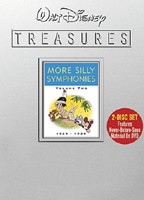 BUY IT AT AMAZON: CLICK HERE!
BUY IT AT AMAZON: CLICK HERE!
STUDIO: Walt Disney Home Video
MSRP: $32.99
RATING: G
RUNNING TIME: 316 minutes
SPECIAL FEATURES:
• Introduction by Leonard Maltin
• Galleries
• Audio Commentary
• Silly Symphonies Rediscovered
• Animators At Play
The Pitch
Cartoons with synchronized rhythmic noises. The genius!
The Humans
Leonard Maltin and hundreds of dancing creatures.
The Nutshell
Have an urge to watch animals, plants, various inanimate objects and one or two humans dance? Thirty-eight shorts spanning nine years should satiate that need. Walt Disney Treasures More Silly Symphonies Volume Two finishes off the series of musical toons with some great, some rare, and some decent offerings.

Satan is just another punk bitch without the cape.
The Lowdown
Some prefer Bugs, others Mickey, and a select few eternally doomed children might prefer Shrek. Wherever your allegiances may lie, the Silly Symphonies were the ingenious starting point for modern animation. Everything about these shorts was groundbreaking. From a technological standpoint, nothing similar had been tried before. The Symphonies became the proving ground for everything else that came from Disney animation. The Symphonies were also an important litmus test on the acceptability of animation. The shorts popularity, even more popular than the Mickey Mouse shorts at the time, set the stage for full-length animated features. As historical entities, the Silly Symphonies are worth celebrating, but if that wasn’t enough, these shorts are still joy-filled morsels of entertainment.
Walt Disney Treasures More Silly Symphonies Volume Two includes shorts from 1929 through 1938. Like most of the Disney Treasures collections, you won’t find all classic cartoons because then there wouldn’t be a need for multiple volumes. That’s my one major beef with this series of DVD’s, but maybe I’m just a capitalistic fearing panty-waist. Despite not being jammed to the gills with classic material, the overall content is very good.
Some of the more memorable cartoons included in this set are, Moth and the Flame, Cock O’ the Walk, Three Blind Mouseketeers, Bugs in Love and Little Hiawatha. Each of these stand the test of time and multiple viewings. Any of these could be shown in replacement of a current kids’ cartoon series and still captivate the audience. They are simple, yet clever, dated in their look, but timeless in their imagination. There are clever gags throughout, and the musical cues are near perfect.
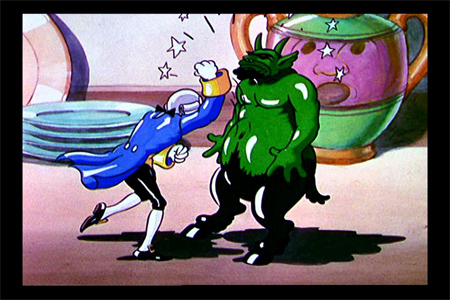
An accurate depiction of the birth of our glorious nation.
Even the oldest cartoons are enjoyably visceral. The early beginnings of the series kept things very simple. There wasn’t much in terms of story. The shorts’ primary goal was about mastering the synchronization of animation and music. It’s all about cutting rug in the early Silly Symphonies. It didn’t matter what type of animal or object you were, if you weren’t dancing, then get the fuck out. All of the dancing does get repetitive when watching the set in large chunks at a time. However, picking one cartoon at random per day would negate this minor problem.
I found viewing them in chronological order to be historically fascinating. As the years progressed the improvements were pretty astounding. Walt Disney began to strive for greater amounts of story in all of his shorts. The cartoons go from being an excuse to throw in as many gags as possible to full-fledged stories with gags as enhancement to that story in a short span of time. The scores become more theatrical, with composers being hired to create new music, as opposed to licensing out classic songs. The animation also improves considerably throughout the set. Rubber hose limbs are replaced with life-like parts imitating real physics. The obvious use of technicolor also comes into play.
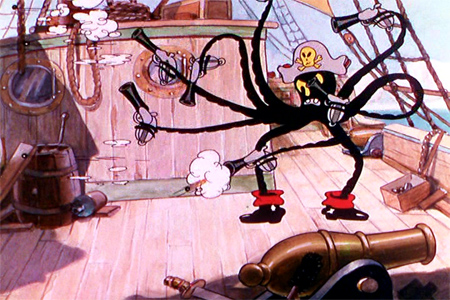
This is easily my worst nightmare.
The only natural step after the Silly Symphonies was full-length features. By the time this series had completed its run, Disney proved to himself, his staff, and financiers that a feature could not only be possible, but successful. Walt Disney Treasures More Silly Symphonies Volume Two is a very solid collection of animation history, that never fails to entertain.
This set also contains several cartoons with racist material. These cartoons all feature an introduction by Leonard Maltin. Maltin puts these shorts in context with the times, but never once tries to justify them. It’s a nice added touch to see a corporate mouthpiece steer clear of excuses and simply present the material for what it is, letting the viewer make their own decisions about the cartoons’ intentions.
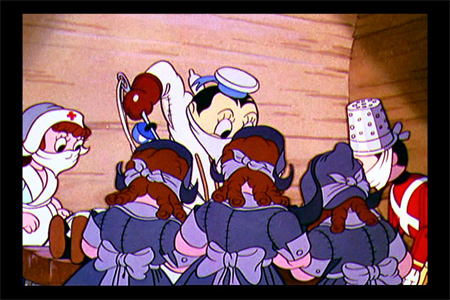
Nothing says good old fashioned family fun like unnecessary surgery.
The Package
The Walt Disney Treasure DVD’s are all nicely packaged. Each release is streamlined and uniform, much like a Disney Cast Member. There is a tin case, decent sized booklet, photo card and certificate of authenticity. I was a bit surprised that there weren’t more special features considering the higher standard a tin case creates in the mind of the consumer. There are several galleries, but they are only interesting to a point. Without any captions or tidbits to go with the galleries, what’s the point really?
Animators at Play is a six minute look at rare backstage footage. This special feature shows the animators and Walt playing a spirited lunch time game of baseball. It doesn’t provide any insight to the cartoons, but it does paint a fascinating picture of the workplace environment Walt tried to create. The other special feature is titled, ‘Silly Symphonies Rediscovered.’ This fourteen minute featurette gives an overview of the significant technical achievements found in this collection. While interesting, it’s merely a fluff piece, barely skimming the surface of the material. Stop saying how important these cartoons are, instead prove it with a compelling and in depth featurette.
More than a dozen cartoons include an audio commentary. Experts in music, animation and Disney historians contribute to the commentaries. They are all fairly informative and engaging. The commentaries save the extras from being very run of the mill. Where the other two specials features felt superficial, the commentaries provide the acumen these shorts deserve. Some of the commentaries focus squarely on the musical intricacies and the animation techniques. Others speak of how the cartoons relate back to the time of their premieres. All of them are enjoyable, just like these classic cartoons.
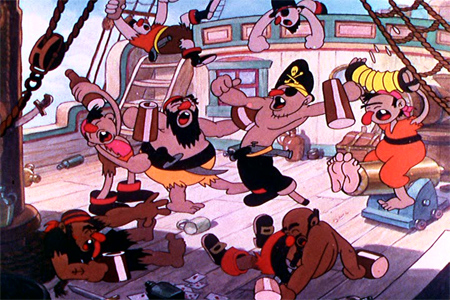
Welcome to Cleveland where just making the Finals is cause for debauchery.